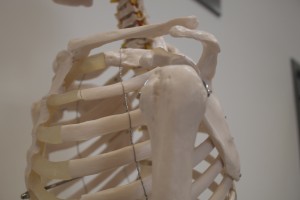Dislocated shoulder
Rehab training for the injury
(see bottom of page under Rehab training for special conditions)
Rehab 1 – Rehab 2 – Rehab 3 – Rehab 4
Description of dislocated shoulder
A dislocated shoulder (glenohumeral luxation) is when the head of the upper arm (caput humeri) slips partially or completely out of the glenoid cavity. The injury occurs relatively frequently in the shoulder because of great range of motion which causes it to have poor passive stability. Most commonly, the humerus is displaced forwards (anterior luxation), since the glenohumeral ligament (the z-shaped ligament) leaves a weak point between the 2 upper ligament strokes. Posterior luxation is rare and is therefore not described here. The reason for dislocation is mostly contact sports and as a resulting injury from a fall which can happen in skiing, cycling and running on roller skates. A person who has already had a dislocated shoulder is at higher risk for repeated injury; especially if the person participates in contact sports. After 2 – 3 dislocations of the shoulder, it is usually necessary to operate to prevent the shoulder from re-luxating during regular every day activities. IMPORTANT!: In rare cases, the luxation may affect the nerve and blood supply to the arm.
Symptoms of dislocated shoulder
- Clear shoulder deformity where the shoulder is no longer round.
- Extreme pain especially when trying to move.
- Muscle spasms.
- No movement, the arm hangs limply down the side.
Examinations for dislocated shoulder
- Analysis / Inspection / Palpation / ROM (Movement Test)
Treatment of dislocated shoulder
Should be examined by a doctor as soon as possible; The sooner, the shorter the healing phase. Until medical help is received the follow should be done:
- Fix / lock the arm in a sling.
- Do not try to put the arm back into place.
What the doctor can do:
- Make sure that the large nerves of the arm are not damaged.
- Take x-rays to exclude fracture.
- Put the shoulder in place using local anesthesia.
- Rare case surgery.
What you yourself can do:
- Get yourself a figure-of-eight bandage / sling.
- Kinesiology tape.
- K-laser.
- Traumeel pills (2 tabl. 3 g.daily for 9 days).
Rehab training
As soon as possible or as soon as the pain allows it; typically after 24-48 hours, the patient must start with isometric tension exercises and ROM exercises that do not affect passive stability.
Isometric exercises are done while keeping the shoulder static, the arm in contact with a door and pushing against the door without moving in the shoulder. The exercise is done in all directions with pressure forward, backward, outwards, and inwards.
ROM exercises can be done by laying the upper body on a dining table, with the arm hanging freely downwards. From here, the arm is moved into circles with increasing range of motion, i.e. bigger and bigger circles as the movement improves. It’s ok to push the shoulder a little so you can feel it, but do not push beyond the pain limit.
After the 1-3 weeks immobilization period is over, the arm should be able to lift vertically and to carry out circular exercises without pain. If this is the case, Rehab 1 can be started.


Social Medier